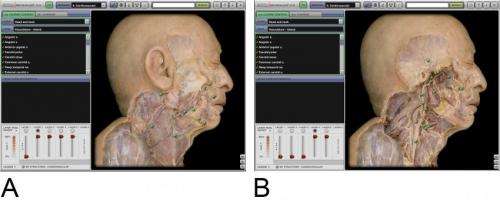Cadavers beat computers for learning anatomy

Despite the growing popularity of using computer simulation to help teach college anatomy, students learn much better through the traditional use of human cadavers, according to new research that has implications for health care.
Cary Roseth, associate professor of educational psychology at Michigan State University, said the study suggests cadaver-based instruction should continue in undergraduate human anatomy, a gateway course to medical school, nursing and other health and medical fields.
In the United States, most anatomy courses still emphasize the use of cadavers, although in many cases digital technologies supplement the instruction. Yet there is a growing debate over whether cadavers are needed at all; some medical schools in Australia and the United Kingdom have stopped using cadavers to teach anatomy altogether.
The research, which appears in the September/October issue of Anatomical Sciences Education, is the only known scientific study to directly compare the effects of cadaver-based and computer-simulation instruction on students' learning of cadaver-based structures.
"Our findings indicate that educational technology can enhance anatomy instruction but is unlikely to fully replace cadavers," said Roseth, who co-authored the study.
A better question, Roseth said, is how to properly balance the use of digital technologies with cadaver instruction in anatomy classrooms. The controversy has intensified in recent years as the increasing costs of cadaver instruction is weighed against the decreasing costs and increasing capabilities of modern technologies.
Roseth's co-authors were Andrew Saltarelli, a former MSU doctoral student who's now an instructional designer at Stanford University, and William Saltarelli, an anatomy professor at Central Michigan University.
The researchers studied a semester-long undergraduate anatomy lecture course with 233 students who were assigned to one of 14 labs. One group of students learned on a cadaver and was tested on a cadaver. Another group of students learned on a multimedia learning system and also was tested on a cadaver.
The students were tested on two things: identifying parts of the body and explaining how they worked.
- On identification, the students who learned on a cadaver scored, on average, about 16 percent higher than those who learned on the simulated system.
- On explanation, the students who learned on a cadaver scored about 11 percent higher. This finding was particularly surprising, Roseth said, given that one of the benefits of the multimedia program is that it can show how parts of the body work – such as blood flow through carotid arteries – while a cadaver cannot.
The difference in the average scores, Roseth noted, was essentially the difference between one grade.
"When it comes to learning actual – rather than simulated – human anatomy, the digital representations, even with all of their additional affordances, did not work as well as the cadaver," Roseth said.
Provided by Michigan State University




















